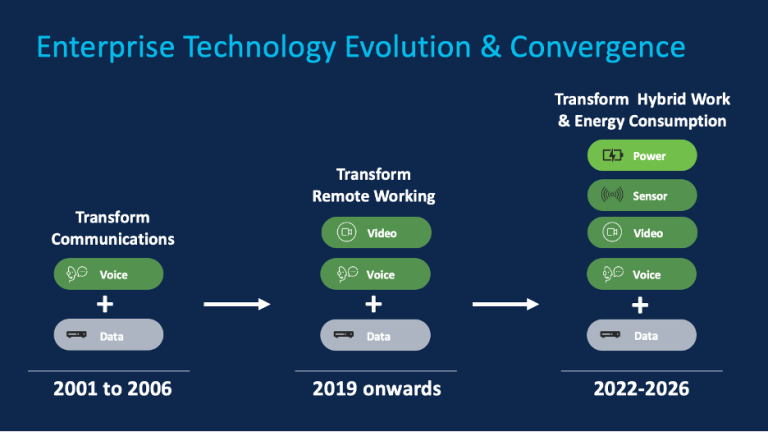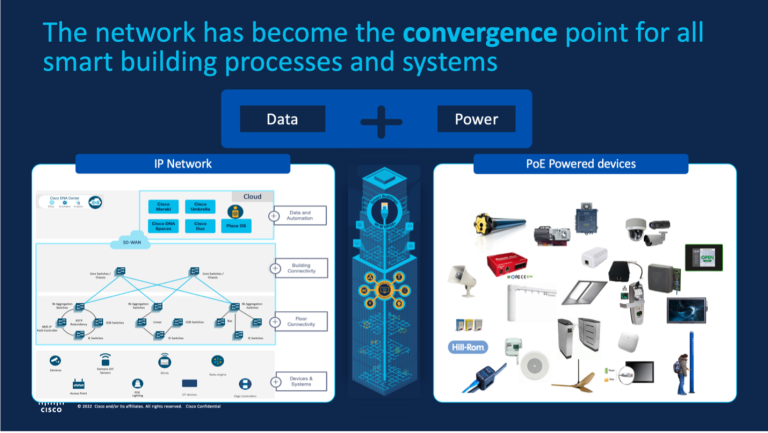Power is known as the 1st utility and ethernet is known as the 4th utility. Their convergence led to the birth of Universal Power over Ethernet (UPoE).
UPoE is a decade-old technology that has been evolving slowly to meet the needs of modern offices. For those building new hybrid spaces or upgrading decades old workspaces, UPoE can deliver cost-effective yet innovative solutions across a variety of domains such as building maintenance, smart infrastructure, sustainability, and more.

Originally introduced in 2001 as Power over Ethernet (PoE), the network could initially only power voice and data applications using ethernet cables. After more than a decade, in 2019, the technology evolved to support video use as well. Now, with UPoE, we can use the network to bring a multitude of devices to life.
Imagine being able to power and control all the tiny sensors, devices, and electrical appliances in your reimagined hybrid workspace – on a single dashboard. You could deploy policies to orchestrate everything to make staff feel welcomed when they come to work as individuals or teams and optimize power consumption to make the facility more sustainable. UPoE has great potential, and the time for its commercial adoption has come.
Why UPoE is at an inflection point now
Facility managers are realizing that they need more data to understand what is happening in their buildings so that they can manage them better, make them safer, and better serve occupants.
To do this, they need sensors, and they need to power and connect those sensors to a central dashboard. UPoE has evolved to provide up to 90W of power from each port (from just 15W in the initial days) of a switch. IoT devices (or ‘things’) too have become more energy efficient requiring less power to operate over the past decade. As a result, a single port can connect up to 11 ‘things’.
Wondering how many ports a single switch has? That depends on its specific configuration. The Catalyst 9400 4-slot chassis, for example, can offer up to 192 ports; the same switch with a 10-slot chassis can offer as many as 480 ports.

Multiplying 480 ports by the 11 ‘things’ each can support brings the total number of things that a single switch can support up to 5,280. Isn’t that amazing? You can definitely start to imagine why the return on investment (ROI) on UPoE has become significant all of a sudden and why the technology is now at its inflection point.
Two large players in Asia have already adopted this technology – CapitaLand and Larsen & Toubro Realty. You can click on their names to learn exactly how they’re using UPoE.
UPoE really is the default for forward-looking organizations reimagining and preparing their facilities such as offices & buildings, retail facilities, sports stadiums, and airports.
Understanding the basics of UPoE
UPoE is an alternative to installing electrical wall circuits and as a result, eliminates the need for power outlets (plug points) as well as AC-DC adaptors and connectors; as a result, UPoE doesn’t need much specialist labor to deploy or saves on electrical equipment and materials, providing a clear cost advantage. Given the simplicity of the way it operates, it also makes maintenance much simpler.
If you look into the mechanics of it all, there is an immediate 45% reduction in energy waste since all devices use DC power directly instead of converting to AC power – as explained in the diagrams below.


This also makes for a better user experience for staff. People don’t need to worry about their plug fitting in power outlet or bringing adaptors. They can also leave their bulky laptop chargers at home. With UPoE, everything is powered by a standard ethernet cable. It’s easy and effective.
Further, because everything in the facility is powered by the ethernet cable, the organization has more granular control over the myriad sensors, cameras, lights, and other connected devices used by the organization. Adopting UPoE is certainly one way to open the floodgates to IoT adoption for a multitude of user groups, allowing the office or building to become a state-of-the-art facility in no time.
In the past, the biggest barrier to UPoE’s widescale adoption was the fact that it could not support devices that needed more than 30 watts of power. Today, thanks to Cisco’s cutting-edge technology, it can deliver up to 90 watts of power per switch – which is more than enough to support a host of applications.
How UPoE contributes to sustainability and simplicity
With UPoE, we use the ethernet cable to deliver power to IoT devices such as sensors, lights, and thermostats – but that same cable also transmits data. That means, with information carried back to the central management system, the facilities manager can better monitor occupancy, appliance and device utilization, use of power, and so on, and use policies to reduce waste and optimize for energy efficiency.
Further, that data can also be used to identify hotspots around the facility to make them more comfortable for staff while also boosting energy savings.
Using thermostats and cameras to set a suitable temperature; using sensors to automate blinds, maximize the use of natural light, and reduce the use of LED bulbs where possible; and leveraging cameras to secure the perimeter without requiring on-site security personnel, are all great examples of how UPoE facilitates simplicity and contributes to sustainability.
If you look at the Leadership in Energy and Environmental Design (LEED) and the Energy Star programs, commercial facilities can only become truly sustainable when they become optimize how they use energy.
Is UPoE reserved for new constructions only?
The most exciting thing about UPoE is that it is not reserved for new buildings coming up in this era. It can be retroactively deployed at facilities built several decades ago – at minimal cost.
While Cisco is promoting UPoE to its customers, it is also using the technology to build cutting-edge office spaces for its employees.
You may have heard of the smart office we built in New York. The building is called PENN1 and is home to an entire ecosystem of IoT devices that collect 5,000 data points in real-time from a host of smart devices across the office.
Those devices are all powered by UPoE, because of which, we’re able to save energy, reduce costs, and be mindful about meeting our sustainability goals. What’s more? It allows us to create smart, future-ready workspaces that people actually want – this is especially important as 70% of our workspaces now serve as collaboration spaces instead of being reserved for individual work.
Cisco is doing everything possible to adapt to hybrid work and delight staff. It’s smart building model – on display at PENN1 – has become incredibly successful. You can watch a video Wall Street Journal produced on YouTube if you have a few minutes to spare. Cisco is already replicating the results in Atlanta and in other offices soon.
Think of UPoE as the lifeblood of the organization, connecting everyone and everything, in real-time. Organizations can leverage it to build delightful experiences, turning office spaces into people magnets, creating workspaces that facilitate collaboration. Cisco’s technologies – from Meraki to Webex devices to an entire ecosystem of IoT devices – all play a major role in that transition – and UPoE can power all of that and more.
UPoE can be deloyed in old facilities just as easily as it can be deployed in new ones. It is a clear winner in this new era and is the gold standard for those looking to modernize their buildings and office space.
The ability to deliver an exceptional employee experience while measuring and optimizing your real estate portfolio is the new norm. The use of data and technology to optimize and transform your offices is the foundation for unlocking the true value of space. UPoE is at the center of all this, transmitting data and power between thousands of devices and a centrally intelligent hub. The time for UPoE is now, whether you’re designing a new building or reimagining an old one.
Indeed the technology for Smart Work Place and Smart living